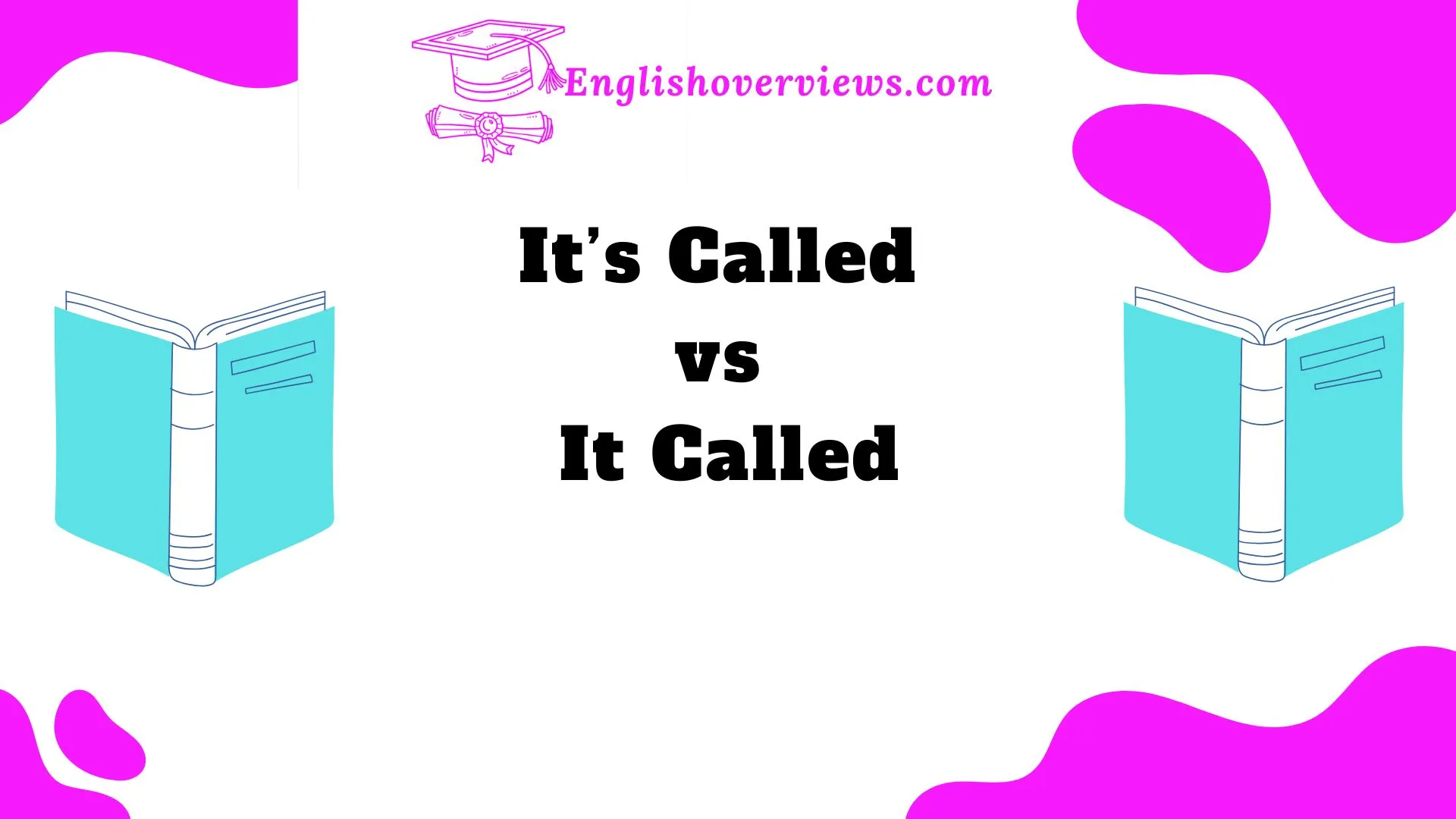When you’re writing or speaking, clarity is key. One of the most common sources of confusion for English learners is the difference between “it’s called” and “it called.” Though these two phrases sound similar, their meanings and uses are quite different.
Misunderstanding this distinction can lead to errors in both written and spoken communication, making your message unclear.
In this blog post, we’re diving into the real differences between these two phrases, offering real-world examples, easy-to-follow explanations, and practical tips to help you master their correct usage.
By the end of this post, you’ll have a strong understanding of how to use “it’s called” correctly and avoid common mistakes.
The Core Difference: ‘It’s Called’ vs. ‘It Called’
The first step in understanding this distinction is recognizing how these two phrases function differently. Let’s break it down:
- “It’s called” is a contraction of “it is called” or “it has called.” It’s used when talking about the name or identity of something (e.g., “It’s called the Eiffel Tower.”).
- “It called” refers to the past tense of the verb “call” (e.g., “It called out my name.”). It is used to describe an action that happened in the past.
In simpler terms:
- It’s called = Something is named.
- It called = Something performed an action in the past.
Understanding the Apostrophe: The Contraction ‘It’s’
The apostrophe in “it’s” is the key to understanding the contraction. In English, we often shorten words by combining them with an apostrophe, such as “it is” becoming “it’s”. Here’s a deeper look:
What is a Contraction?
A contraction is when two words are combined into one with an apostrophe replacing the missing letters. For example:
- “It is” becomes “it’s”
- “It has” becomes “it’s”
The Role of the Apostrophe
In “it’s,” the apostrophe signals that a letter or two has been left out for ease and speed. The phrase “it is” (or “it has”) becomes “it’s” without changing the meaning. It’s essential to remember that the apostrophe does not indicate possession here. If you were talking about something belonging to “it,” you’d use “its” instead of “it’s”.
The Meaning and Usage of ‘It Called’
Now, let’s talk about “it called”. This phrase may sound similar to “it’s called,” but it has a completely different meaning.
- “It called” refers to the past tense of the verb “call”. It is used when describing something that did an action, usually in the past.
Real-World Example
Imagine you’re telling a story. You might say, “The dog called out to me” to describe a time when the dog barked or made a sound. In this case, “called” is the past tense of the verb “call.”
This is completely different from saying “it’s called” which would indicate the dog’s name, like “It’s called Max.”
Key Takeaway
- “It called” = Describes an action that happened.
- “It’s called” = Describes a name or title.
‘It’s’ as ‘It Is’ vs. ‘It’s’ as ‘It Has’
“It’s” can stand for two different things, “it is” or “it has.” This versatility is one of the reasons why many learners struggle to get it right. Here’s a deeper look into both meanings:
It’s as ‘It Is’
When “it’s” stands for “it is,” it’s used to talk about the current state of something or to introduce a subject.
- Example 1: “It’s called the Grand Canyon.” (Current name or title)
- Example 2: “It’s raining outside.” (Current state)
It’s as ‘It Has’
When “it’s” stands for “it has,” it’s used to describe something that has occurred or is happening, usually followed by a verb in the past participle form.
- Example 1: “It’s been a long time.” (It has been)
- Example 2: “It’s rained a lot today.” (It has rained)
How to Properly Use ‘It’s Called’ in Sentences
The phrase “it’s called” is primarily used when giving the name or title of something. You’ll typically use it to identify objects, places, animals, or even ideas.
Examples
- “It’s called the Louvre.”
- “It’s called the Internet.”
- “It’s called a golden retriever.”
Remember, you’ll be using “it’s called” to introduce names, titles, and descriptions. It’s also used in a more formal sense when you’re giving exact titles or labels.
Real-World Example
If someone asks you the name of your favorite book, you could respond:
- “It’s called The Great Gatsby.”
Common Misconceptions About ‘It’s Called’ and ‘It Called’
A common mistake many people make is mixing up “it’s called” with “it called”. Let’s take a closer look at why this happens and how to avoid it:
Misconception #1: Using ‘It Called’ When You Mean ‘It’s Called’
It’s easy to slip into using “it called” when you’re actually trying to talk about the name of something. However, as mentioned earlier, “it called” refers to an action, not a name. For example, you should say:
- “It’s called the Eiffel Tower,” not “It called the Eiffel Tower.”
Misconception #2: Confusing ‘It’s’ with ‘Its’
Don’t confuse “it’s” (the contraction) with “its” (the possessive form).
- “It’s” means “it is” or “it has.”
- “Its” shows possession, meaning something belongs to “it.”
- Example: “It’s raining” (It is raining), vs. “Its color is blue.” (The color of something belonging to “it” is blue.)
Possessive Pronouns and the Role of ‘It’ Without an Apostrophe
When discussing possession, “it” becomes “its” without an apostrophe. Here’s the difference:
| Form | Meaning | Example |
| It’s | Contraction of it is or it has | “It’s called the Amazon River.” |
| Its | Possessive form of it | “The cat licked its paws.” |
Remember: “It’s” with an apostrophe is a contraction, while “its” without an apostrophe shows possession.
Practical Examples: Using ‘It’s Called’ Correctly in Different Contexts
Let’s see real-world examples where “it’s called” is used correctly. Whether in formal, informal, or everyday speech, understanding how to use this phrase will improve your communication.
- Informal Setting: “It’s called a sandwich, but you can call it whatever you like.”
- Formal Setting: “It’s called the Declaration of Independence. It outlines our core values as a nation.”
- Everyday Conversation: “It’s called The Walking Dead, and it’s a really good show.”
The Role of Contractions in Formal and Informal Writing
Contractions like “it’s” are used frequently in informal writing, but in formal writing, it’s best to avoid them. Here’s why:
Informal Writing
- Example: “It’s been a long day.”
- Why it works: Casual and conversational tone
Formal Writing
- Example: “It has been a long day.”
- Why it works: More professional and clear
In formal writing, you’ll often avoid contractions to maintain a more serious tone. In informal settings, contractions help keep the conversation natural and easygoing.
Helpful Tips and Tricks to Differentiate Between ‘It’s’ and ‘It Called’
Here are some simple tricks to keep in mind:
- “It’s called” always refers to a name or title.
- “It called” refers to an action that happened in the past.
- If you’re unsure, replace “it’s” with “it is” and see if it makes sense.
- If you’re talking about possession, use “its” (no apostrophe).
Why Understanding the Difference Between ‘It’s Called’ and ‘It Called’ Matters
Properly using “it’s called” vs. “it called” can make your communication clearer and more effective. Whether you’re giving a name, describing an action, or simply writing or speaking more precisely, these distinctions are crucial.
FAQs
What’s the difference between ‘it’s called’ and ‘it called’?
“It’s called” refers to the name or title of something, while “it called” describes a past action.
How can I remember when to use ‘it’s called’?
If you’re introducing a name or title, use “it’s called”. If you’re describing something that happened in the past, use “it called.”
Can I use ‘it’s’ as a possessive?
No, “it’s” is a contraction for “it is” or “it has.” The possessive form is “its” (no apostrophe).

Alyan Ashraf is the creative mind behind English Overviews, a platform dedicated to helping learners master the English language. Passionate about education and language development, Alyan specializes in simplifying complex English concepts, making learning accessible for students of all levels.











